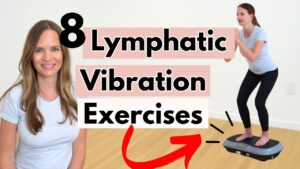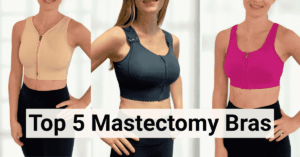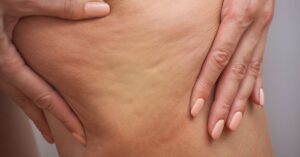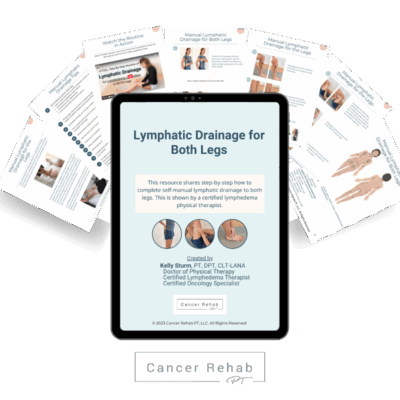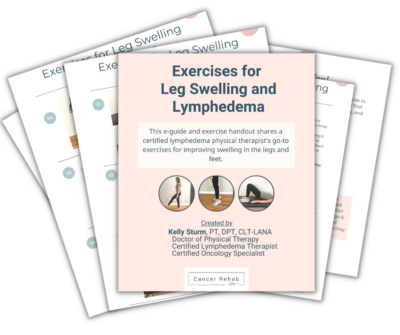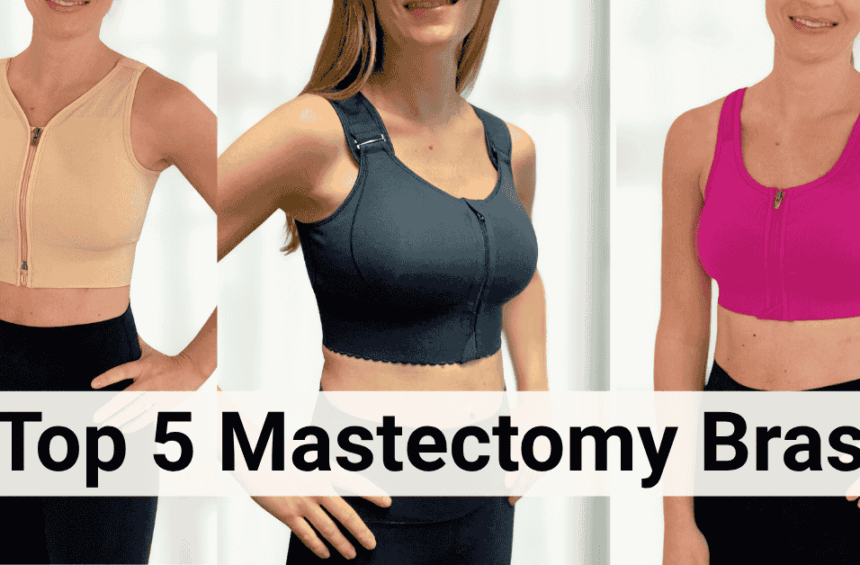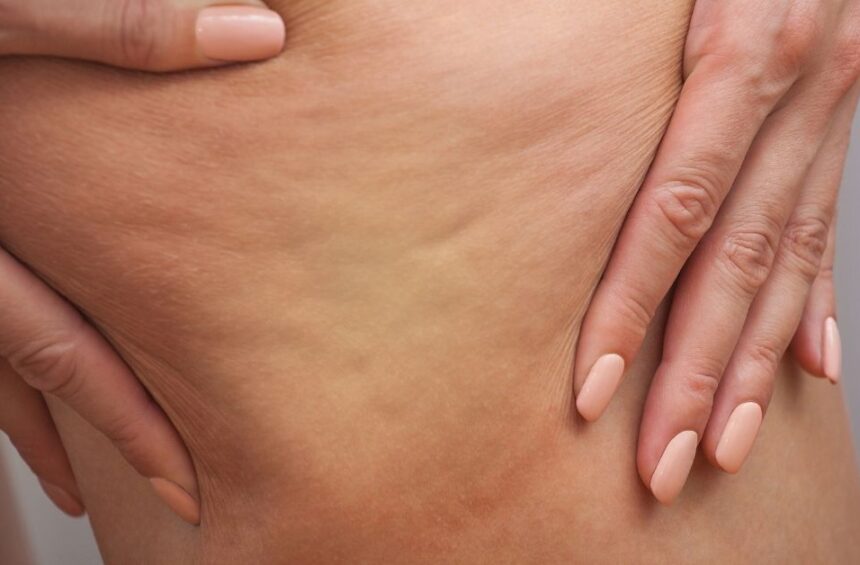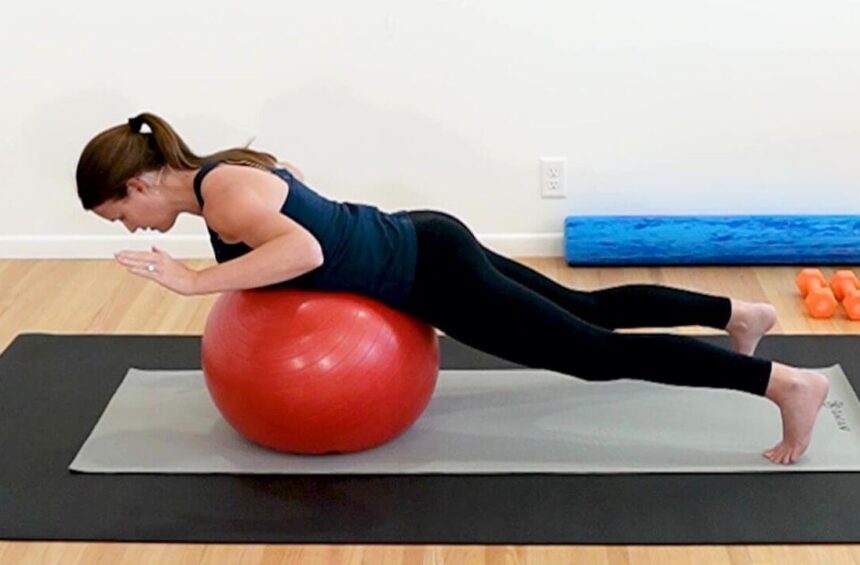Vibration plates are used as a way to move lymphatic fluid and increase blood flow through muscle activation. These targeted vibration plate exercises for beginners are designed to promote lymphatic flow, support detoxification, and ease fluid buildup. They are ideal for those managing lymphedema, post-surgical swelling, or looking to enhance overall wellness.
My name is Kelly, and I am a certified lymphedema therapist. In this guide, I am sharing a targeted lymphatic drainage exercise and strength routine that can be done on a vibration plate.
Whether you’re new to vibration therapy or a regular user, this routine is safe, effective, and easy to follow, as long as you are cleared by your healthcare professional for safety.
Why Start with Whole Body Vibration Training?
For beginners, vibration plate training offers unique advantages over traditional exercise. Vibration plate benefits include improved bone mineral density and increased musculoskeletal and neuronal interactions, which are especially helpful if you have physical limitations. In fact, research suggests that even just standing on a vibration plate can increase muscle activation and improve circulation.
And when it comes to fat loss? A systematic review showed that adding whole-body vibration therapy to a healthy lifestyle can lead to small but meaningful reductions in body fat, particularly when paired with consistent exercise and a healthy diet. That’s why doing gentle exercises on the plate—not just standing or sitting—can give you the most bang for your buck.
As a physical therapist, I often recommend vibration plate training for people who:
- Are new to exercise or just getting back into a routine
- Don’t have a lot of time for long workouts
- Need gentle lymphatic or muscle stimulation
- Want to stay active or lose weight, but find regular exercise boring or uncomfortable
The beauty of vibration plate exercise is that you can start as gently as you need, and build up over time in both duration and intensity as your body gets stronger.
Getting Started: What You Need to Know
Safety First
Before you step onto your vibration plate, it’s important to make sure it’s safe for you to use.
Always check with your doctor first if you have:
- Heart conditions or pacemakers
- Recent surgeries or injuries
- Pregnancy
- Blood clots or circulation problems
- Severe osteoporosis
- Any chronic or underlying health conditions
What You’ll Need
- Vibration plate (For the exercises shown below, I use Lifepro’s Vibration Plate, which you can get with a 10% discount through my affiliate link. )
- Optional: resistance band or light dumbbells (2-5 lbs)
- Water bottle
Vibration Plate Full Body Workout for Beginners
This full-body workout focuses on simple, safe movements that anyone can do using a vibration plate machine. For beginners who are new to vibration plate training, each exercise should be done for 20-30 seconds. As you get more comfortable, you can gradually increase to 45-60 seconds.
Start with these settings:
- Lowest vibration frequency (usually 15-20 Hz)
- Take breaks whenever you need them
If you would like to follow along with a certified lymphedema therapist completing these exercises, you can watch the YouTube video below.
Initial Lymph Node Stimulation
Prior to starting the exercises, it’s beneficial to open up the pathways where your lymph nodes are.
- Step onto your vibrating platform (you may choose to be near a wall if you need something to hold onto).
- Take your whole hand, skin to skin, and do 8 to 10 gentle circles on your clavicle. Then repeat on the other side.
- Next, using your whole hand, complete 8 to 10 circles around the lymph nodes by your ears.
- Complete 8 to 10 circles in each armpit.
- Complete 8 to 10 circles in your groin region, where your sitting crease is.
- Finish by taking a deep breath and slowly reaching both hands up and over your head before releasing your breath and bringing your arms back down.
Upper Body Movements
For these upper-body strength movements, you may choose to use light dumbbells in your hands.
1. Shoulder Press Sequence
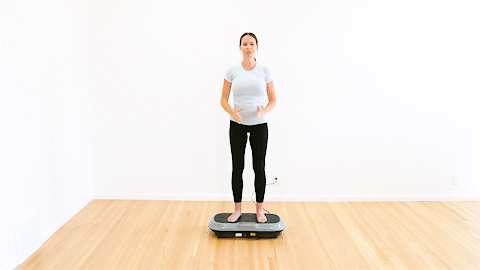
- Start by standing comfortably on the vibration plate with feet shoulder-width apart.
- Bring your arms up to shoulder height and bend your elbows at a 90-degree angle.
- Slowly press your arms up overhead, then slowly lower back down.
- Repeat.
Why it helps: This movement helps activate muscles in your arms and shoulders.
2. Bicep Curls into Push Press
- Start with your arms at your sides.
- Bending at your elbows, slowly curl up toward your shoulders, then press your hands up overhead.
- Lower back down with control.
Why it helps: This weight training movement works your entire arm while promoting lymphatic drainage.
Simple Lower Body Exercises
3. Lateral Taps

- Begin in a small squat position.
- Step one foot to the side, tapping your toe down. Bring the foot back in to meet the other.
- Keep your weight in the standing leg the entire time and kick out in a straight line for proper form.
- Switch Legs.
***Hold onto something nearby if you need support to maintain balance.
Why it helps: Side-to-side movement helps activate lymphatic vessels along the sides of your body while improving balance and coordination.
4. Mini Squats
- Stand with feet comfortably apart on the vibration plate.
- Lower down just a few inches (like you’re sitting back into a chair) into a squat position, then return to standing.
***Don’t worry about going deep – small movements are perfect for beginners.
Why it helps: Squats activate your biggest muscle groups, creating powerful pumping action for lymph in your legs.
5. Heel and Toe Raises (Calf Raises)

- Lift up onto your toes for 2 seconds, then rock back and lift your toes up for 2 seconds.
- Alternate between these positions.
***This exercise is great even if you have balance issues, since you stay in one spot.
Why it helps: This targets your calf muscles, which are like a second heart for pumping lymph fluid up from your legs.
Whole Body Movement Patterns
6. Reach Across – Oblique Twist
- Stand with feet hip-width apart and arms at your sides.
- Reach your right hand across the body towards the left, allowing your torso and hips to rotate.
- Return to the starting position. Then repeat with your left hand, reaching across to your right.
- Move slowly and keep your core engaged.
Why it helps: This engages your obliques and core muscles while promoting coordination and lymphatic flow across the torso.
7. Ballerina Reaches

- Stand tall and slowly reach one arm up and slightly to the side (like a graceful ballerina pose).
- Hold for a moment, then switch sides.
- Focus on making the movement smooth and controlled.
Why it helps: This opens up your torso and helps stimulate lymphatic flow along your sides and under your arms.
BONUS! One Advanced Vibration Plate Exercise
This last movement is a more advanced vibration plate exercise. You may choose to do mini squats rather than the reverse lunge.
8. Reverse Lunges

- Stand tall with your feet slightly narrowed on the vibration plate.
- Step one foot back into a lunge, off the plate-lowering your hips until both knees are at about 90 degrees.
- Push through your front heel to return to standing.
- Alternate legs.
*** Use support if needed for balance.
Why it helps: Reverse lunges activate large muscle groups in your legs and glutes, supporting strength, balance, and circulation – especially when combined with whole body vibration.
Your First Time on the Vibration Plate
If you are new to vibration plate exercises, when you first step on a vibration plate, it might feel strange! This is completely normal, and over time, you will become more used to the whole body vibration.
Some people find that after vibration plate exercises, they feel itchy! This is likely a histamine reaction, which is common after doing a new exercise. This decreases the more consistent you are with the vibration plate.
What Happens Week by Week
Week 1: Most people feel awkward and maybe a little tired. This is normal! Your body is adapting to new sensations.
Week 2-3: You’ll start feeling more balanced and comfortable on the plate. Many of my patients tell me they no longer get itchy and start to feel more muscle activation.
Week 4 and beyond: This is when people really start noticing the vibration plate benefits – feeling less stiff, having more energy, and some notice reduced swelling.
Don’t feel like you need to do all 8 exercises right away. In my experience, those who start slowly and build gradually are more consistent long-term and are less likely to burn out with a new routine.
Building Your Confidence
Many of my patients are nervous about trying something new, especially if they haven’t exercised in a while. Here’s what I tell them:
There’s no “perfect” way to do these exercises. The goal is simply to move your body gently while getting the benefits of whole body vibration therapy. If you can stand on the plate and do some simple movements, you’re doing it right.
If someone is struggling with muscle fatigue or balance, it’s also okay to sit on the plate or sit in a chair and put your feet on the vibration plate.
Signs You’re Ready to Progress
After a few weeks of consistent training, you might notice:
- Better balance on the vibration plate
- Exercises feeling easier
- More energy after sessions
When you feel ready, you can:
- Increase exercise time to 45-60 seconds
- Add light weights or a resistance band while performing exercises
- Move on to other exercises that are more advanced like push-ups, reverse lunges, or triceps dips
Can Vibration Plates Help Me Lose Weight?
This is one of the most common questions I get! While vibration plates aren’t a magic solution for weight loss, they can be a helpful part of your overall health routine.
Vibration plates work by helping with muscle activation, which can support your metabolism. Many of my patients find that regular vibration plate workouts help them feel more energized and motivated to make other healthy choices throughout their day.
Remember, sustainable weight loss comes from combining gentle movement, good nutrition, and consistent habits. The vibration plate can be a great starting point, and has been shown to help aid weight loss when combined with a healthy lifestyle – but not necessarily alone.
Time to Start Your Vibration Training Journey
Remember, everyone starts somewhere. The fact that you’re reading this and considering vibration plate exercise means you’re already taking a positive step for your health – so I applaud you for that!
The lymphatic system responds well to gentle, consistent stimulation. You don’t need to be an athlete or push yourself to extremes. Simple, regular movement on a vibration plate can make a positive difference in how you feel.
Take it one day at a time, listen to your body, and be proud of every small step forward.
Frequently Asked Questions
I’ve never exercised before – is a vibration plate safe for me?
Yes, vibration plates are actually great for exercise beginners because the vibration does much of the work for you. However, you should always check with your doctor first before using a vibration plate, especially if you have any health conditions. Start with the lowest settings and shortest time periods, then gradually build up as you feel comfortable.
How long should my first vibration plate session be?
For complete beginners, I recommend starting with just 5-10 minutes total. Do 3-4 exercises for 20-30 seconds each with rest breaks between. Many of my patients are surprised by how tired they feel after such a short session – the vibration makes your muscles work harder than you realize.
What if I feel dizzy or uncomfortable during the exercises?
If you feel dizzy using a vibration plate, stop immediately and step off the plate. You should never push through significant discomfort and should consider connecting with your doctor to talk about it. If cleared, try shorter sessions, lower vibration settings, or take more breaks between exercises.
Can I use a vibration plate if I have arthritis or joint problems?
Many people with arthritis find vibration plates helpful because the vibrations can improve circulation and reduce stiffness. However, you should use the lowest settings, keep your knees bent, and avoid any movements that cause pain. Always get clearance from your doctor or physical therapist first.
How long before I see benefits from vibration plate exercises?
Most of my patients notice some changes in how they feel within 2-6 weeks of consistent use. Some changes they note are things like less stiffness, more energy, increased strength, and better lymphatic flow. Consistency matters more than intensity for beginners.

